HCHS President's Message
I was honored to have been invited to attend the reunion of the USS Henrico held in Norfolk, Virginia on October 22-25. Also representing the Historical Society was Corresponding Secretary, Beverley Davis. Beverley (Bev) is a former president of HCHS and is currently Chairman for the Historic Preservation Advisory Committee appointed by the Henrico County Board of Supervisors.
The reunions of the USS Henrico are held every two years and I had been in touch periodically with Betty Soper, who is the organizer, since planning began after their last reunion. What a pleasure it was to meet the veterans and their families who came from all over the United States, including Texas, California, Iowa, Wisconsin, Idaho, Maine, Missouri, Minnesota, Michigan, the state of Washington, Montana, South Carolina, Massachusetts, as well as Virginia. You can visit with them on their website, http://www.henricoAPA45.org.
Betty explained how the USS Henrico was named as the result of a contest to sell war bonds. The area selling the most bonds had a ship named in their honor. The citizens of Henrico County have a long history of supporting our country.
During the reunion the USS Henrico Reunion Association transferred the artifacts and memorabilia of their ship over to the Henrico County Historical Society as repository, and I was honored to accept the items on behalf of the society. The collection includes photos of the ship dating 1945-1967 and a piece of the Japanese Kamikaze plane that flew into the ship causing extreme damage and loss of life. These items will be stored at the Society office. The USS Henrico and her crews served with honor in war and in times of peace until the ship was decommissioned in 1968.
According to an article in the Richmond Times-Dispatch, 16.1 million Americans served in the armed forces during WWII. Only an estimated 2.5 are still alive. Nationwide, WWII veterans are passing away at the rate of almost 1,000 a day. We have a special connection with the veterans who served aboard the ship named in honor of Henrico County, and I look forward to attending the next reunion to be held in 2010 in St. Louis, Missouri.
Recently, the conference scene has been quite busy.
Preserving for the Future: A Capital Idea! The 23rd annual Virginia Preservation Conference was held by APVA Preservation Virginia and the Virginia Department of Historic Resources at the Richmond Metropolitan Convention and Visitors Bureau on October 5-7th, 2008. The conference offered programs featuring a variety of subjects including sustainability; rural and urban planning; cultural landscapes; tourism; and historic preservation and technical issues for homeowners and the historic preservation commissions.
A session on statewide African American Historic Preservation was held at the Sixth Mount Zion Baptist Church followed by a tour of Jackson WArd. As an added bonus, guest speaker, Governor Timothy Kaine, reiterated his support of preservation efforts, specifically mentioning Fort Monroe, the management of which will be transferred from military control to the Commonwealth of Virginia in 2011.
The Virginia Genealogical Society and the Tidewater Genealogical Society held their annual fall conferance November 1st at Christopher Newport University. The conference featured speakers Jeanne Eubanks, Carolyn Goudie, Paul Heinegg, and Donald Moore. A number of topics were discussed including 17th century settlement patterns in the Hampton Roads area, free African Americans in Virginia, North Carolina, and South Carolina, Virginia's Land records and genealogical materials at the Mariners' Museum. As another aadded bonus, John McCain held a political rally at the same hour on the lawn next to the building where the conference was held, so we caught a glimpse of him and his wife Cindy before he lost the election.
We have certainly experienced history in the making!
Sarah Pace
President
>Back to Top<
In Memorium: Margaret Mize Thistlethwaite, 1919-2008
We are greatly saddened by the death of Margaret Thistlethwaite on August 27, 2008.
Margaret, a founding member, served on the Executive Board of the Henrico County Historical Society in a number of capacities including 1st Vice President, Corresponding Secretary, and Director of the Three Chopt District.
During her service with the Historical Society, Margaret was especially concerned with preservation and regretted the loss of any historic property. She was tireless in promoting the history of Henrico and encouraged the saving of Walkerton, cedar HIll and Nuckols Farm, all of which were puchased by Henrico County. Margaret represented the Three Chopt District on the Historic Preservation Advisory Committee and was also Director of the Three Chopt District for the Association for the Preservation of Henrico Antiquities.
Margaret was instrumental in the recognition of Oak Grove as a threatened property. The current owners were the recipients of the 2008 Historic Prservation Advisory Committee Award of Merit for their restoration of the historic property at a ceremony held on October 30th; and so her work continues.
We will miss her smile and her dedication to the history of Henrico County.
She is survived by one daughter, Margaret Mize Jones and her husband, Glenn; three sons, Gary Mize and wife Betty, John Mize and wife, Sharon, and Dennis Mize and wife Pat; one stepson, Bob Thistlethwaite Jr; seven grandchildren, David Mize, Craig Mize, Susie Mize, Frankie Mize, Nicki Jones, Tim Mize, and Debbie Greene; eight great-grandchildren; and one sister, Virginia Snelson.
>Back to Top<
2009 HCHS Calendars
They're here, and they are great for gifts

The calendar features 12 historic Henrico County churches depicted in warm sepia tones. It includes images of both original and present-day structures for the churches and a brief history of each. The cover is a four-color hand tinted etching of St. John's Church, originally called Varina Parish and once a part of Henrico County. An introduction by Louis Manarin traces the importance of houses of worship in the county.
You can order yours by phone or mail. Proceeds from calendar sales will fund a scholarship for a Henrico County history student.
The cost is $12.00 plus $.60 tax and $5.00 shipping and handling for a total of $17.60.
Send payment to
The Henrico County Historical Society
PO Box 90775
Henrico, VA 23273-0775.
or
Call Sarah Pace at 804-830-2407.
Make checks payable to The Henrico County Historical Society.
Enjoy learning about the history of some of Henrico County's churches, and support the learning of a Henrico County history student.
>Back to Top<
Remembering the USS Henrico
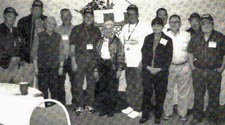
Veterans from the USS Henrico gathered in Norfolk on October 22-25 for a reunion. Part of the festivities included the presentation of artifacts associated with the ship and its attack by enemy suicide bombers to the society. Pictured are members of the crew posing with HCHS's Bev Davis, President Sarah Pace and organizer, Betty Soper.
One member of the crew who was not in attendance was Tom Love, Radioman First Class. Tom is a Plank Owner, which means he was on the ship before it was actually under commission. Prior to the shakedown, Tom and a draft of nine men were sent to the east coast to man the ship.
From his home in Dixon, Illinois, he sent this recollection of the April 2 attack on the Henrico. It appeared in the March 2008 issue of the Henrico's newsletter and is reprinted here with Mr. Love's permission.
It was April 2nd, 1945-5:50 p.m. Myself, Leon Setzer, McNair and Lawrence Nannery (Scotty) were on duty in the radio shack. Scotty came in to relieve one of us, and since I had an easy circuit to care for, and Scotty wanted to finish his paperback book, he asked me if he could take over my spot. Since I had nothing else to do, I was hesitant to go, but Scotty talked me into it. AS I walked away, Scotty made the statement, "Send me roses." There was no reason for him to make such a statement since we were not under attack or at general quarters. I walked out of the back hatch (I am guessing 25 or 30 feet) to the deck just aft of the radio shack. There was a soldier standing there (who should have been down below where he belonged), and at that time I heard a plane coming in and I started to say, "That one was pretty close." I didn't even finish the sentence before we got hit.
It hit the wheel house direct. He had two five hundred pound bombs that penetrated several decks and also tore up the radio shack. The concussion knocked me down, but I didn't suffer any wounds. However, the soldier suffered shell shock according to the medics and had to be sedated. About fifteen seconds had elapsed since Scotty had relieved me. We never found any trace of Scotty as there was a big hole in the deck where he was sitting. This spot is shown pretty clearly in the film that I had received from my friend Les Saunderlain. McBride was the first one to come out of the place, and he had blood coming out of every opening in his head. I tried to lay him down so I could help anyone else that was to come out. They were all pretty well banged up, but Scotty was the only one killed. By the way, that was Easter Sunday, and my mother had gone to Mass that morning and lit three candles for her three sons in service. Two Navy and one Air Corps.
Regardless of what has been said about any ship helping us, we were on our own because they thought we were going to blow up due to our cargo of gasoline and ammunition for ground troops. It wasn't until the next morning until we had the fire under control that another ship threw us a tow line, as we were powerless. Also, the next morning I was trying to get down to my bunk through eight or ten inches of water, and in the dark, I bumped into something lying on the deck. McBride had made it that far, and he became the second fatality of our gang. In the rest of our time at Okinawa, they estimated 2700 or 2800 suicide planes were shot down or hit other ships.
>Back to Top<
Fair Today, Gone Tomorrow: State Fair of Virginia ends 62-year stay at Strawberry Hill
Informational Sources:
Christopher M. Gregson, ed. Inventory of Early Architecture. Henrico County, Va. 1998.
Louis H. Manarin and Clifford Dowdy. The History of Henrico County, Charlottesville University of Virginia Press, 1984.
Lou Ann Meadows Ladlin and Wayne Dementi. State Fair: More than a Midway, 2006.
Lisa Crutchfield. "Make memories at the State Fair of Virginia", Richmond Times-Dispatch, 22 Sept. 2008.
Jeff O'Dell. Inventory of Early Architecutres and Historic and Archeological Sites, Henrico County, 1976.
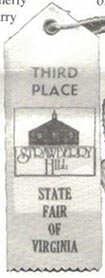
When the State Fair of Virginia ended its 2008 run on October 5th, its relationship with Henrico County passed into the history books. In 2009, Caroline County will take over the role of host that Henrico has enjoyed more than the 62 years of the Fair's run at the Laburnum Avenue location of Richmond International Raceway, formerly known as Strawberry Hill.
Henrico's hosting of the fair predates the Civil War. In 1859, the fair outgrew its gounds at Western Square, which is now Monroe Park, on Belvidere Streeet and ventured westward into Henrico County to find a larger site on West Broad Street, near where the Science Museum of Virginia is located today. At that time, the property was part of Henrico County. Successful fairs were held there in 1859 and 1860.
Because of the Civil War and its afternmath, no more fairs were held until 1867, when the Virginia Horticultural and Pomological Society sponsored a poorly attended exhibition. However, the fair of 1869 again brought in crowds of visitors, including travelers drawn to Richmond to witness the unveiling of Stonewall Jackson's statue in Capitol Square. The fair grew and prospered during the 1870s and 1880s. Highlights from these years included a visit in 1877 from President Rutherford B. Hayes, his wife, and Secretary of State William M. Evarts.
Changing boundary lines between Richmond and Henrico and a need for more space took the fair from the county into the city. However, its 72 acres located between Hermitage Road and North Boulevard, purchased by the Virginia State Fair Association (VSFA) in 1906, had ties to Henrico. The Diamond baseball field stands today once belonged to the Bryan family as part of their estate.
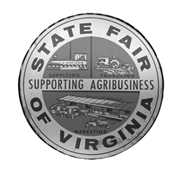
The fair returned to Henrico in the 1940s when, once again, larger fairgrounds were needed. In 1942, the VSFA struck a deal to purchase the historic Davenport estate known as Strawberry Hill for $45,000. In his Inventory of Early Architecture and Historic and Archeological Sites in Henrico County, Jeff O'Dell writes of the Strawberry Hiill site: "This large plantation lay just east of Pickinocky, overlooking the Chickahominy River basin." Of the neighboring Pickinocky plantation, O'Dell says: "Pickinocky was a 19th century plantation located on the road side of Bridge Road (now the Richmond-Henrico Pike) along the bluffs of the Chickahominy River." Both Strawberry Hill and neighboring Pickinocky, which most likly took its name from a local Native American group, were noted on maps from the Civil War period.
During Reconstuction after the Civil War, Strawberry Hill plantation, owned by Isaac Davenport, Jr., was used by the U.S. military. Between the end of the war in 1864 and the withdrawal of troops in 1870, some owners in Henrico and Richmond were forced to rent their land to the military to provide space for the construction of military necessities, which included campsites, hospitals, depots, wharves, and officers' quarters. These property owners were supposed to be paid rent, but they received only partial payment before General Montgomery C. Meigs, the chief quartermaster, ended the payments. Along with 26 other owners, Isaac Davenport, Jr. petitioned Congress to enact legislation to pay them for the use of their property. Their petition, however, failed to produce the desired results, and the owners received no additional reimbursment for the use of their land.
Sixty-six years later, another war had an impact on use of Strawberry Hill. Once the VSFA had completed its purchase of Strawberry Hill at a price of less than $10 per acre, it had to wait until the conclusion of WWII before working on the fairgournds and holding a fair. During the war years, the government banned non-essential construction, so the new fairgrounds could not be developed.
However, when the war was over, planning began in earnest. The VSFA hired New York architect William Lawrence Bottomly (1883-1951) to design the fairgrounds. Bottomly already was popular in the Richmond area for his design of Colonial Revival houses. One souch house is Redesdale on River Road. Bottomly used Westover and Carter's Grove as examples for this house, which was built in 1925 for Leslie H. Reed, the resident agent for the Imperial Tobacco Company of Great Britain. Bricks from the Manakin Brickworks were used in the construction of Redesale. Landscape architect Charles F. gillette designed the Redesdale's grounds and those of the interior court of the headquarters building of Reynolds Metals, which was featured in an article in a recent edition of the Henrico Historical Society newsletter.
When Bottomly designed the Old Dominion Building at the Strawberry Hill Fairgrounds, his reputation for quality design was well known. This building, orignally called the Covered Ring, is made of brick and features a hipped roof with twin cupolas over a two-story exhibition space. Visitors ahve appreciated the beauty of its utilitarian style since it was introduced to fairgoers in 1946.
To say that the State Fair of Virginia prospered at its Strawberry Hill location is an understatement. Midway rides and shows delighted the young and old. Livestock, poultry, and agriculture exhibits educated city folks about rural life. Fairgoers relished the sights, sounds, smells, and fireworks brought into Henrico County each year. In many years, local residents gave the Fair credit for bringing much needed rain after dry summers.
In the 1960s, over half a million visitors passed through the gates of the annual fairs. As Fair attendance grew, so did the need for additional buildings to house more exhibitions. A grandstand for horse show events was built, along with the Women's World Build, the Commonwealth Building, and the horticulture building, to accommodate the Virginia State 4-H Horse Show.
New construction continued in the 1970s with the addition of sound stages, Youth World, and the American Heritage Showcase. In 1971, the dirt gave way to asphalt when the midway was paved.
In the 1990s, Strawberry Hill hosted a variety of events in addition to the annual State Fair of Virginia. These events included the Richmond Highland Games and Celtic Festival, performances at the Classic Amphitheater, and the Strawberry Hill steeplechase races. The fairgrounds also featured the Richmond International Raceway, which purchased Strawberry Hill from The State Fair of Virginia, Inc., in 1999.
While the State Fair organization searched for new fairgrounds, the State Fair continued to be held at its long-time Henrico home on Laburnum Avenue, now named the Richmond International Raceway complex, until the end of its 2008 run. In 2009, the State Fair of Virginia will welcome visitors to its new fairgrounds at The Meadow Event Park in Caroline County. In preparation for the move, memorabiliia has been given to the Library of Virginia to be used for research and exhibits. As the Fair makes its way to Caroline County, we say goodbye to this long-time Henrico tradition and wish it continued success in its new location. It's been a very good ride.
>Back to Top<
America's First College, Almost
A noble plan in Henrico predates Harvard's founding, but was cut short.
Sources:
W. Gordon McCabe. "The First University in America: 1619-1622. The Virginia Magazine of History and Biography.Vol. XXX, 133-56.
Louis H. Manarin and Clifford Dowdy. The History of Henrico County. Charlottesville: University of Virginia Press, 1986.
While Maassachusetts rightly claims to have established the first college in America, plans for a college in Virginia, and more specifically in Henrico, predated Harvard's 1636 founding by 19 years. Unfortunately, however, those plans were quashed by disastrous events in 1622.
The impetus for the establishment of a college apparently came from the visit of Pocahontas, John Rolfe, and their infant sone Thomas and twelve young Indians to England in 1616. She was received with great fanfare by the court and the people, and this made her unexpected death in March 1617, on the eve of her planned return to Virginia, momentous. Within a few days of her burial, King James I issued his "special grant and license" instructing his archbishops to direct their bishops to make collections "for the erecting of some churches and schools for ye education of ye children of those Barbarians in Virginia." Collected funds were to be turned over the Treasure of the Virginia Company.
Sir Edwin Sandys, a dominant figure in the company at the time, and others began setting up a plan of education for Virginia, leading from free-school to college, and eventually to university. The intended to found a "Colledge" for "training Indian children in the true knowledge of God and in some useful employment" and to educate the sons of white planters who "through want therof have been hitherfore constrained to their great costes to send their children from thence to be taught."
In early 1619, collections for the college amounted to approximately 1500 pounds, apparently a sizable sum. The Virginia Company's Minutes indicate that it contributed "Ten thousand acres of land for the University to be planted at Henrico and one thousand acres for the College for the conversion of Infidels." The land lay on the north side of the river from the town of Henrico to the falls. In the following year, George Thorpe was sent out to be the "Deputy" for the "Colledge lands" occupying both sides of the river.
Work did not begin immediately because, according to the Virginia Company's Minutes, "it was conceived fittest to forbear building the Colledge awhile, and to begin with the money we have to provide Annuall Revennue, and out of that to begin the erection of said Colledge." Cultivating the land for tobacco and cereal crops would constitute an endowment fund for the college. Thorpe expanded the experiment by adding grapes and silk culture.
The overall plan seemed to be for a system rather than a single institution. A 550 pound donation in 1620 by a benefactor signing as "Dust and Ashes" was added to a 150 pound donation by the Southampton Association to establish at Southampton Hundred a school which would be dependent on the Colledge."
Additionally, Rev. Patrick Copeland collected funds for a school or church while onboard a ship from India to England. He informed the Company of its purpose, and the Company decided to add to it for a school at "Charles Cittie." It was "to be called in honour of the donors the 'East Indie School.'" At the meeting of October 30, 1621, it was recorded that "It was also thought fit that this as a Collegiate or free schoole should have dependence upon the Colledge in Virginia, w'ch shall be made capable to receave Schollers from the Schools into such Scollerships and fellowshipps as the said Colledge shall be endowned withal for the advancement of schollers as they arise by degrees and desertes in learninge."

The plans were underway with brick-makers contracted for and Rev. Copeland elected as "Rector of the Colledge" when tragedy struck on Good Friday, 1622. Pretending to be friendly, Indians under the leadership of Opecancanough gained access to the settlements in the area and massacred some 347 colonists. Among them was George Thorpe, who had earlier built Opecancanough a house in hopes of aiding in his conversion. He had approached the Indians unarmed, hoping to mediate the situation, but he was murdered and his body mutilated.
Word of the massacre did not reach England until mid-July during a special "Thanksgiving Service" sponsored by the Company, where Rev. Patrick Copeland, ready to board ship for Virginia, delivered an address ironically entitled "Virginia's God be thanked, or a Sermon of Thanksgiving for the Happie Successe of the Affayres in Virginia this last yeare."
While the 1622 massacre certainly delayed, if not destroyed, the plans for the college, the dissolution of the charter of the Company two years later sounded its death knell. It would be another 70 years before plans for a college in Virginia would come to fruition with the founding of the College of William and Mary, the second oldest college in the nation, just a little ways down the friver from Henrico.
>Back to Top<
What Do You Know?
Farm wagons never had flats, but they needed a wheel change every once in a while.
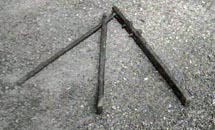
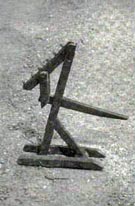
The pictures are from the 2008 Third Quarter HCHS newsletter. These are wagon jacks, one manufactured commercially and one handmade. They were similar in many ways to a modern car jack and were used for the same purpose, to change a wheel. The jack was placed under the wagon axle. With one of the teeth under the axle to be lifted, the handle was moved down. This generally lifted the wheel high enough to allow its removal. If one lift did not raise the axle high enough, the wagon would need to be blocked up, the jack reset, and the process repeated. Once the wagon was at the appropriate height, the jack handle would have to be held in place by a rope or some mechanical device. After the wheel was replaced, the process was reversed.
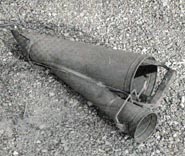
Pictured here is an implement used on farms. It is about 3 feet tall and manufactured of metal.
Do you know what it was used for?
Email your answers to jboehling@verizon.net.
Check our next issue for the answer. All correct respondents will be recognized and congratulated. Suggestions for future "What do you know?" topics will be gladly acepted at the same email address.
>Back to Top<
HCHS Events - Fourth Quarter
Sunday, December 7th, 2:30PM
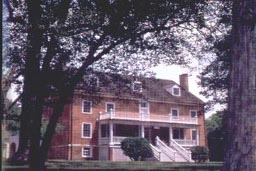
Our December meeting will be held at Walkerton Tavern on Sunday, December 7th beginning at 2:30 p.m. Walterton Tavern is located at 2892 Mountain Road in Glen Allen. Built by John Walker between 1824 and 1825, the structure has not only served as a tavern but also as a store, post office, voting precinct, and possibly a field hospital for wounded Union Cavalrymen in 1864.
We will have a short business meeting, then hear from our guest speaker, have some light seasonal refreshments and conclude with a festive and fun gift exchange for anyone interested in participating. Anyone who does not wish to participate may leave following refreshments or is welcome to stay and watch the fun.
The speaker will be Donald Gunter. The meeting topic will be the Dictionary of Virginia Biography project at the Library of Virginia to which Mr. Gunter has contributed, and he has written an article about Henrico-born singer & songwriter Tommy Edwards.
If you wish to participate, bring a wrapped gift (something from around your house, a regift, something of a historical nature, or something purchased) but please stay in the $5.00 to $10.00 price range. The gift should be gender neutral. Some ideas: movie tickets, a paperback book, homemade or purchased candy or other food items, etc. - use your imagination. The gifts will be placed in the middle of the table and each participant will take turns choosing a gift or "stealing" a gift until all gifts have been chosen. This is always lots of fun and you never know what you may end up taking home.
Please RSVP to Linda Dickerson at your earliest convenience. Linda would be very grateful for contributions of cookies or other items. If you are able to provide something, please contact Linda to let her know. You may e-mail her (preferable): ldickerson@oag.state.va.us or call her at 364-3492.
>Back to Top<
News 2008: Fourth Quarter
First Quarter | Second Quarter | Third Quarter
Home | Henrico | Maps | Genealogy | Preservation | Membership | Shopping | HCHS
|











